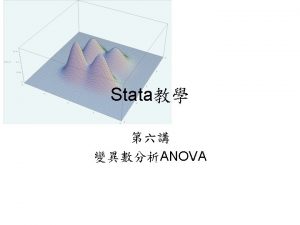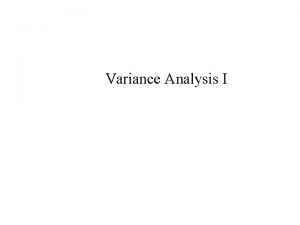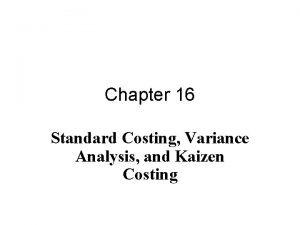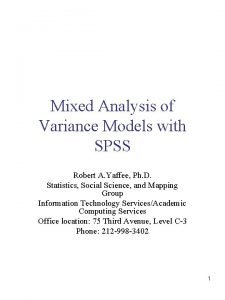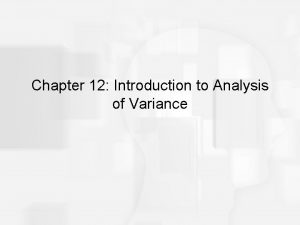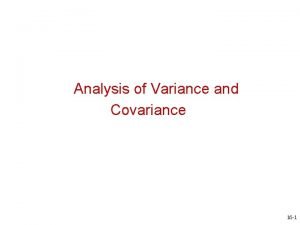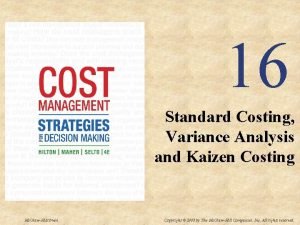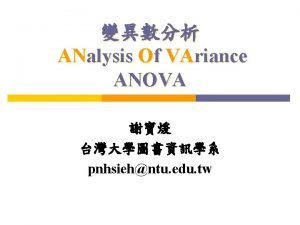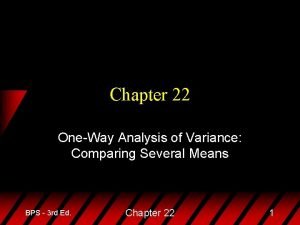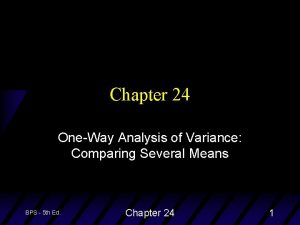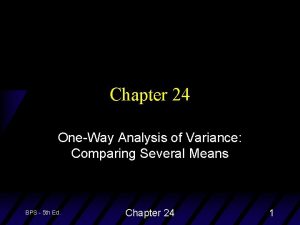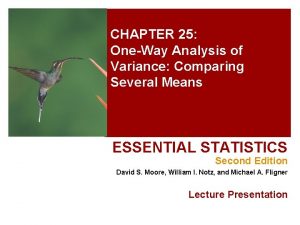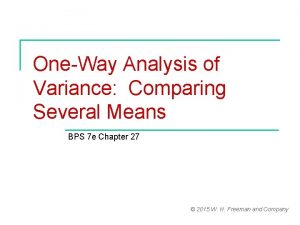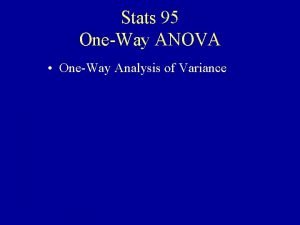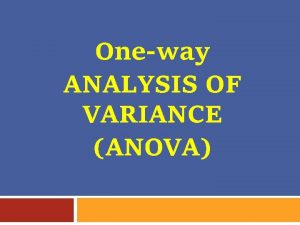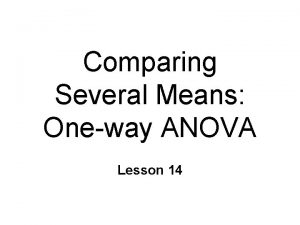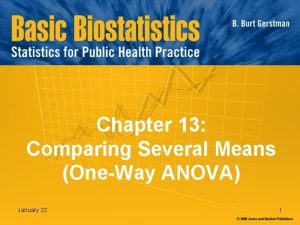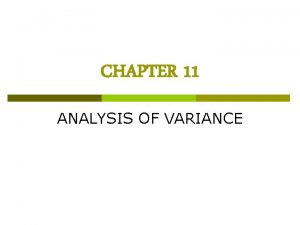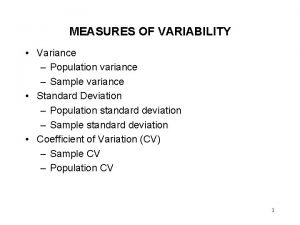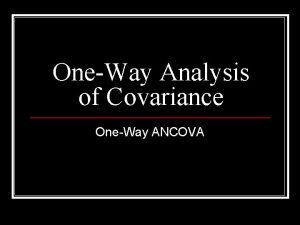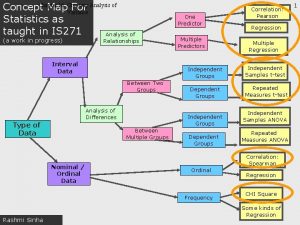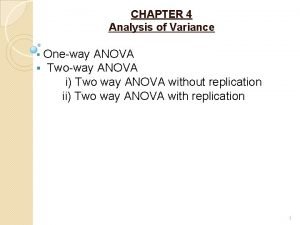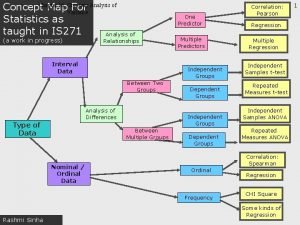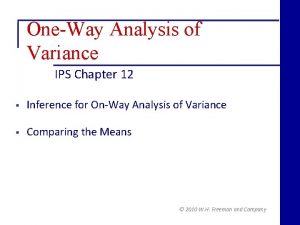CHAPTER 27 OneWay Analysis of Variance Comparing Several






















- Slides: 22

CHAPTER 27: One-Way Analysis of Variance: Comparing Several Means Basic Practice of Statistics 7 th Edition Lecture Power. Point Slides

In Chapter 27, We Cover … �Comparing several means �The analysis of variance F test �Using technology �The idea of analysis of variance �Conditions for ANOVA �F distributions and degrees of freedom �Some details of ANOVA*

Introduction �The two-sample t procedures of Chapter 21 compared the means of two populations or the mean responses to two treatments in an experiment. �We need a method for comparing any number of means. We’ll use the analysis of variance, or ANOVA.

Comparing Several Means � EXAMPLE: Comparing tropical flowers � STATE: The relationship between varieties of the tropical flower Heliconia on the island of Dominica and the different species of hummingbirds that fertilize the flowers were examined. Researchers wondered if the lengths of the flowers and the forms of the hummingbirds' beaks have evolved to match each other. The table below gives length measurements (in millimeters) for samples of three varieties of Heliconia, each fertilized by a different species of hummingbird. Do the three varieties display distinct distributions of length? In particular, are the mean lengths of their flowers different? � PLAN: Use graphs and numerical descriptions to describe and compare three distributions of flower length. Finally, ask whether the differences among the mean lengths of the three varieties are statistically significant.

Comparing Several Means � EXAMPLE: Comparing tropical flowers � SOLVE (first steps): Figure 26. 1 displays side-by-side stemplots with the stems lined up for easy comparison. The lengths have been rounded to the nearest tenth of a millimeter. Here are the summary measures we will use in further analysis: Sample Variety Sample size Mean length Standard deviation 1 bihai 16 47. 60 1. 213 2 red 23 39. 71 1. 799 3 yellow 15 36. 18 0. 975 � CONCLUDE (first steps): The three varieties differ so much in flower length that there is little overlap among them. In particular, the flowers of bihai are longer than either red or yellow. The mean lengths are 47. 6 mm for H. bihai, 39. 7 mm for H. caribaea red, and 36. 2 mm for H. caribaea yellow. Are these observed differences in sample means statistically significant? We must develop a test for comparing more than two population means.

Comparing Several Means �Means: �bihai: 47. 60 �red: 39. 71 �yellow: 36. 18 �The flowers of bihai are longer than either red or yellow, and the spread for the lengths of the red flowers is somewhat larger than for the other two varieties. �Are these differences statistically significant?

Comparing Several Means • (Sample) Means: • Null hypothesis: The true means (for length) are the • bihai: 47. 60 same for all groups (the • red: 39. 71 three flower types). • yellow: 36. 18 • We could look at separate t tests to compare each pair of } means to see if they are different: 47. 60 vs. 39. 71, 47. 60 vs. 36. 18, 39. 71 vs. 36. 18 H 0: μ 1 = μ 2 H 0: μ 1 = μ 3 H 0: μ 2 = μ 3 • However, this gives rise to the problem of multiple comparisons.

Multiple Comparisons �Statistical methods for dealing with multiple comparisons usually have two steps: 1. An overall test to see if there is good evidence of any differences among the parameters that we want to compare. 2. A detailed follow-up analysis to decide which of the parameters differ and to estimate how large the differences are. �The overall test, though more complex than the tests we have met to this point, is reasonably straightforward. Formal followup analysis can be quite elaborate. We will concentrate on the overall test and use data analysis to describe in detail the nature of the differences.

The Analysis of Variance F test �

The Analysis of Variance F test � This alternative hypothesis is not one-sided or two-sided. It is “manysided. ” � This test is called the analysis of variance F test (ANOVA). � EXAMPLE: Comparing tropical flowers: ANOVA � SOLVE (inference): Software tells us that, for the flower-length data in Table 26. 1, the test statistic is F = 259. 12 with P-value P < 0. 0001. There is very strong evidence that the three varieties of flowers do not all have the same mean length. It appears from our preliminary data analysis that bihai flowers are distinctly longer than either red or yellow. Red and yellow are closer together, but the red flowers tend to be longer. � CONCLUDE: There is strong evidence (P < 0: 0001) that the population means are not all equal. The most important difference among the means is that the bihai variety has longer flowers than the red and yellow varieties.

Using Technology P-value <. 05 significant differences Follow-up analysis There is significant evidence that the three types of flower do not have the same mean length. From the confidence intervals (and looking at the original data), we see that bihai has the longest, then red, and then yellow.

The Idea of Analysis of Variance �The details of ANOVA are a bit daunting; they appear in an optional section at the end of this presentation. �The main idea of ANOVA is more accessible and much more important: When we ask if a set of sample means gives evidence for differences among the population means, what matters is not how far apart the sample means are, but how far apart they are relative to the variability of individual observations. THE ANALYSIS OF VARIANCE IDEA �Analysis of variance compares the variation due to specific sources with the variation among individuals who should be similar. In particular, ANOVA tests whether several populations have the same mean by comparing how far apart the sample means are with how much variation there is within the sample.

The Idea of Analysis of Variance � The sample means for the three samples are the same for each set (a) and (b) below: � The variation among sample means for (a) is identical to (b). � The variation among the individuals within the three samples is much less for (b). � CONCLUSION: The samples in (b) contain a larger amount of variation among the sample means relative to the amount of variation within the samples, so ANOVA will find more significant differences among the means in (b). � Assume equal sample sizes here for (a) and (b). � Note: Larger samples will find more significant differences.

The ANOVA F Statistic �

Conditions for ANOVA �

F Distributions and Degrees of Freedom �

F Distributions and Degrees of Freedom �

Some Details of ANOVA* �

Some Details of ANOVA* �

Some Details of ANOVA* �

ANOVA Confidence Interval We can get a confidence interval for any one of the means µ from the usual form estimate ± t*Seestimate using sp to estimate σ. The confidence interval for µi is Use the critical value t* from the t distribution with N I degrees of freedom.

ANOVA Confidence Interval—Example How do the mean lengths of the flowers differ?
 Stata oneway
Stata oneway Owping
Owping Oneway hash
Oneway hash Standard costing formula
Standard costing formula Static budget example
Static budget example The variance analysis cycle
The variance analysis cycle Budget variance analysis
Budget variance analysis Kaizen costing formula
Kaizen costing formula Multivariate analysis of variance
Multivariate analysis of variance Direct materials variances
Direct materials variances Multivariate analysis of variance and covariance
Multivariate analysis of variance and covariance Mpv accounting
Mpv accounting Job cost variance
Job cost variance Spss mixed model
Spss mixed model Variance analysis in nursing
Variance analysis in nursing Flexible budget variance example
Flexible budget variance example Introduction to analysis of variance
Introduction to analysis of variance Analysis of variance and covariance
Analysis of variance and covariance Kaizen emfasis
Kaizen emfasis Standard costing formulas
Standard costing formulas Dawson toys ltd
Dawson toys ltd Variance accounting meaning
Variance accounting meaning Mancova
Mancova
